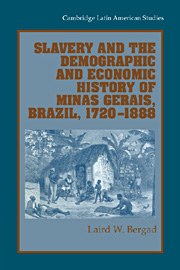Book contents
- Frontmatter
- Contents
- List of illustrations
- List of tables
- Preface
- Acknowledgments
- Maps
- 1 The mining-driven economy and its demise: from settlement to 1808
- 2 Economic transformations, 1808–1888
- 3 Demographic rhythms from settlement to the census of 1872
- 4 Demographic aspects of slavery, 1720–1888
- 5 Economic aspects of slavery, 1720–1888
- 6 Conclusions
- Appendixes
- Glossary
- Bibliography
- Index
3 - Demographic rhythms from settlement to the census of 1872
Published online by Cambridge University Press: 16 February 2010
- Frontmatter
- Contents
- List of illustrations
- List of tables
- Preface
- Acknowledgments
- Maps
- 1 The mining-driven economy and its demise: from settlement to 1808
- 2 Economic transformations, 1808–1888
- 3 Demographic rhythms from settlement to the census of 1872
- 4 Demographic aspects of slavery, 1720–1888
- 5 Economic aspects of slavery, 1720–1888
- 6 Conclusions
- Appendixes
- Glossary
- Bibliography
- Index
Summary
The region comprising the future capitania of Minas Gerais was explored in the sixteenth century and penetrated by numerous bandeiras originating in São Paulo during the second half of the seventeenth century. But settlement on any significant scale did not take place until the discovery of extensive gold reserves in the Ouro Preto/Mariana region in the 1690s. As the news gradually spread to population centers on the Brazilian littoral, migrants began converging on the gold zone, which was first governed together with São Paulo and later officially established as a separate administrative entity in 1720. The route from Bahia followed the São Francisco River and then along the Rio das Velhas to Sabaráclose to the heart of the mining zone. From São Paulo and Rio de Janeiro settlers moved overland along old indigenous trails and blazed new, more direct routes to the gold-producing regions. Royal authority was slow to emerge, and the tasks of imposing taxes, somehow controlling production, counting inhabitants, and monitoring the ever increasing slave population were difficult in an environment where each new rumor of a discovery sparked a movement of people into new, often remote regions in this vast uncharted hinterland of steep mountains and countless rivers. Early censuses were made in the principal areas of settlement and production, and these leave a fairly accurate portrait of the demographic structures in the major mining zones revolving around Vila Rica and Mariana.
- Type
- Chapter
- Information
- Publisher: Cambridge University PressPrint publication year: 1999
- 1
- Cited by



